How to Build an Learning App: A Step-by-Step Guide: Features, Costs, Tips (2025)
- Updated: Nov 14, 2024
- 19 min
E-learning apps are here to stay.
They have boomed during a pandemic, and their growth hasn’t stopped since.
E-learning apps offer flexibility and convenience, making them highly adaptable to different learning styles and needs.
With technology advancing and remote learning becoming more common, they meet the growing demand for accessible education.
Their ability to evolve with new innovations ensures they will remain an important part of both education and professional training for years to come.
That is why e-learning app development is a great way to be at the forefront of the education industry.
In this article, we will dive into online learning app development.
We will explore the market, the benefits you can achieve when developing your own learning app, as well as the nitty-gritty of the development process.
We will discuss must-have features, development tech stack, stages to build educational app, as well as costs to expect.
Before getting into the topic, feel free to discover EdTech startup ideas that can change how people learn and grow.
Now, let’s jump in, shall we?
Get a strategic MVP to mitigate risks.
Understanding E-Learning Apps
Before diving into the development process, we need to identify what we mean by elearning apps.
In general, these applications are educational tools users can download onto their devices (phones, tablets, laptops, or computers).
E-learning apps are designed to make the educational process more accessible, engaging, and simple.
To do so, they offer multiple features like interactive lessons, videos, chatbots, quizzes, and much more.
As education is always in need, educational apps have wide target audiences.
There are apps for everyone who wants to learn something new, whether they are for kids, adults, or elderly people.
It is worth noting that e-learning apps can be used for various purposes.
Based on this factor, there are academic, corporate, and personal development educational apps.
We have explored the corporate type of educational software in our blog about employee training software development.
Feel free to check it out if you are thinking of launching an employee training application.
E-learning Market Overview
As we’ve mentioned before, education will always be in need.
Let’s now explore this thought a little bit further.
Here is an overview of the most recent e-learning market reports from the leading industry insights providers.
Specifically, we share data from the Grand View Research report and GM Insights analysis.
The online learning market has grown rapidly since 2000.
It has become the fastest-growing part of the education industry.
Over this time, it has increased by more than 900%, according to Oxford College.
This growth is expected to continue, with a yearly growth rate of 9.1% until 2026.
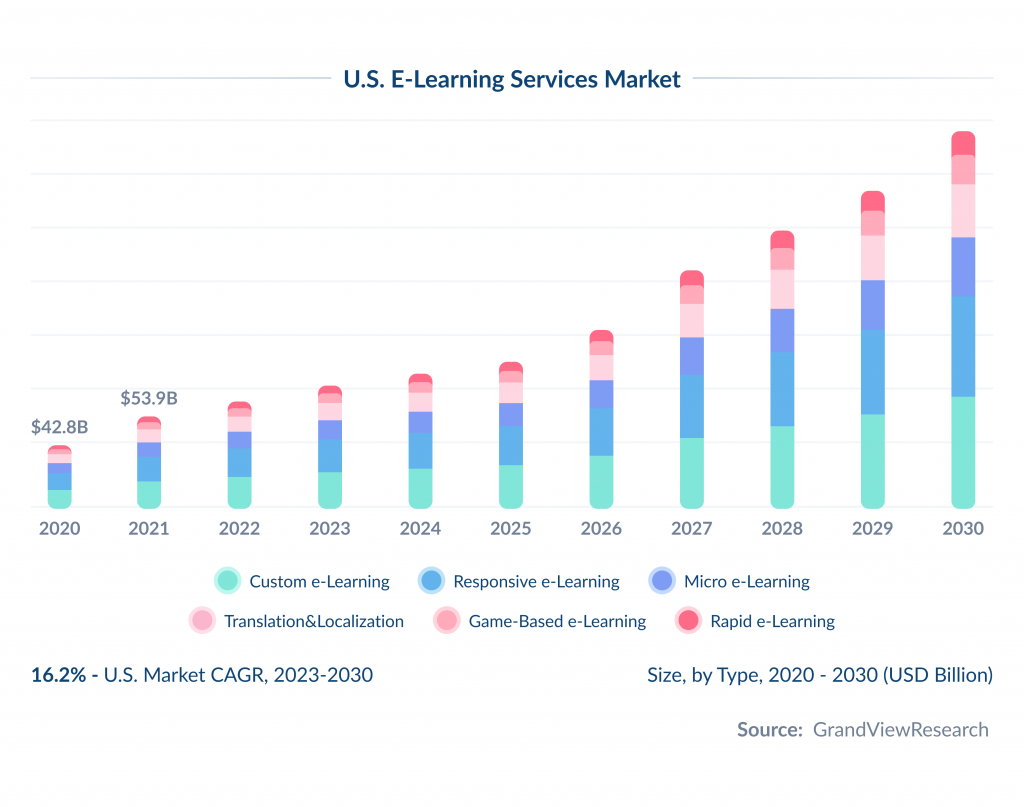
There are several factors that fuel this remarkable growth.
Two major drivers are the increasing demand for digital skills and the spread of e-learning into different industries.
Let’s investigate them further.
As technology evolves, there’s a greater need for skills in areas like IT, digital marketing, and data science.
To keep up, people and companies have started to use various e-learning platforms for training.
This trend is expected to continue and fuel the market growth in the future.
E-learning is also expanding into fields like corporate training, K-12 education, higher education, and healthcare.
Healthcare professionals, for example, rely on e-learning for certifications and to simplify their workflows, like in the case of EMR systems development.
This broad expansion shows that e-learning penetrates into multiple industries and learning apps are slowly but surely becoming a key part of the future of education.
Another important growth factor we cannot ignore is the rise of mobile learning.
The flexibility and accessibility of mobile apps make them appealing to both individuals and organizations.
End Users of Educational Apps
Let’s explore the end users of educational apps in more detail.
Based on end-users, the market is segmented into academic, corporate, and government.
According to the industry report, the academic segment had the largest revenue share of 46.5% in 2022.
It is expected to maintain its position over the forecast period.
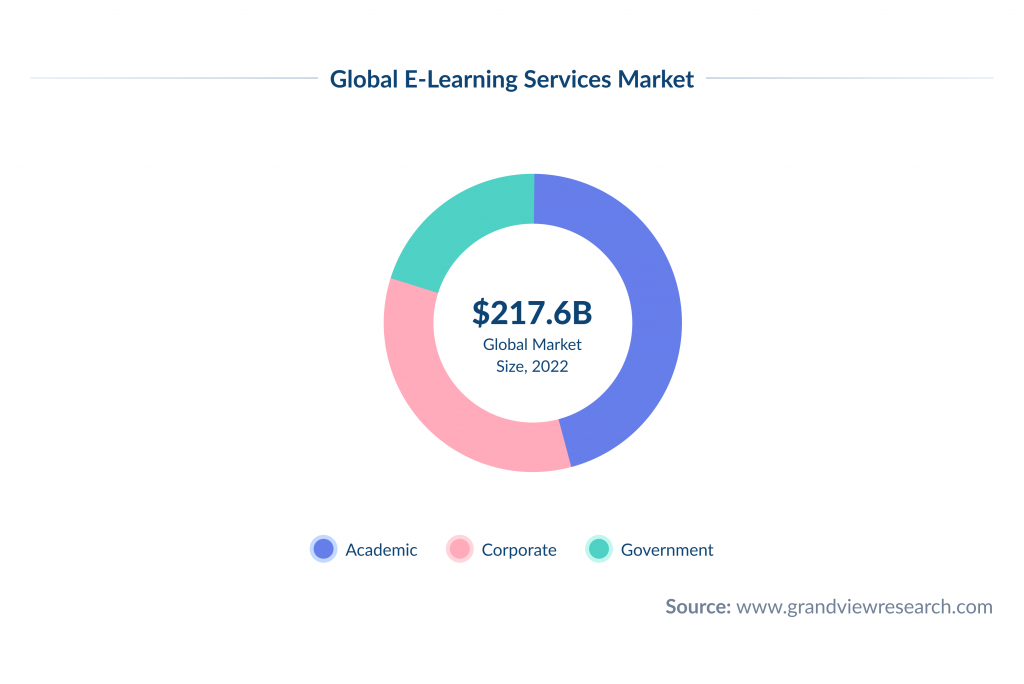
And it is no wonder that e-learning plays a key role in the academic sector.
It provides an innovative and technologically driven approach to education.
Integrating e-learning in academics has become a truly transformative factor in education, elevating traditional teaching methodologies.
According to the statistics from Ispring Solutions, 63% of high school students in the U.S. use various digital learning tools daily.
Furthermore, 45% of elementary school students incorporate at least one digital learning tool into their daily educational routine.
Based on this data, we can state that e-learning apps continue to develop, catering to their growing audiences.
That means that developing an online learning app is a great idea. But since there are many types of them, which one is the most popular?
According to the industry analysis, Learning Management Systems (LMS) are at the forefront.
They allow companies and educational institutions to easily manage and track their training programs.
These platforms are becoming more popular because they now include cool features like AI and mobile access, making it easier to learn from anywhere.
Learn more about top LMS integrations in our recent post.
Mobile learning is also growing fast.
With more people using smartphones, especially in regions like Asia-Pacific, learning on-the-go is becoming a norm.
Virtual classrooms, which let people interact in real time, and simulation-based learning, great for hands-on training like in healthcare, are other technologies driving the market forward.
Dreaming of creating a unicorn? Here’s how to find an idea for a unicorn startup.
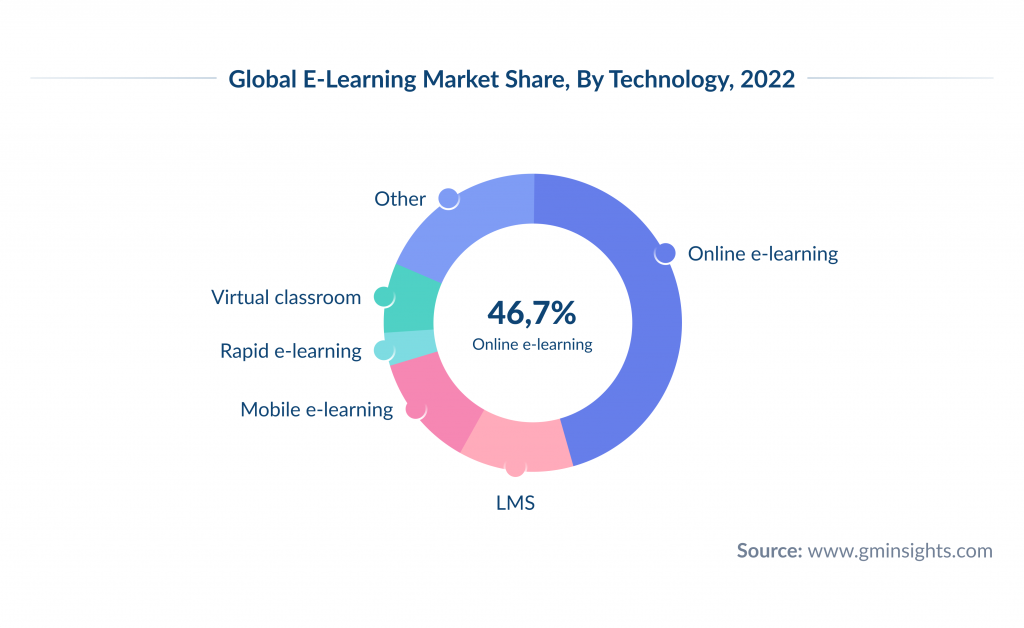
Overall, the mix of demand and the rise of technology is making online learning a key part of education’s future.
And you can be a part of this future with your brand new e-learning application.
Before we dive into step-by-step of developing such an app, let’s explore the benefits you can expect if you decide to build an online learning application.
Benefits of E-Learning Apps
E-learning apps offer a lot of real, practical benefits that make learning easier and more accessible for everyone.
One of the main benefits we have already mentioned.
It is increased accessibility.
Thanks to the rise of mobile apps in the educational sector, users can learn anytime and anywhere.
Let’s take Coursera as an example. Using this app, you can take university-level courses right from your couch, on your own schedule.
Another benefit is the personalization of learning experiences.
Many e-learning apps use algorithms and data to personalize the learning experience. This allows them to offer more tailored content based on the learner’s progress and preferences.
LinkedIn Learning, for example, recommends courses based on a user’s career interests and skill gaps, creating a personalized learning path.
Additionally, e-learning apps are more cost-effective than traditional education.
Online courses are often cheaper than in-person classes, and they eliminate additional costs like transportation and housing.
edX and Udemy offer courses from leading universities at a fraction of the cost, making high-quality education accessible to a global audience.
The majority of the educational mobile apps out there are global, which means you can access them regardless of your location.
This global reach is beneficial for both users and businesses.
This is particularly impactful for individuals in regions where educational resources are limited.
And, as a business owner, you expand your target audience.
Another key advantage is the enhanced user experience through interactive and immersive content.
Many e-learning platforms incorporate features like gamification, simulations, and interactive videos to make learning more engaging and hands-on.
Khan Academy uses interactive exercises and instant feedback to create an immersive learning experience.
Platforms like Coursera and edX integrate real-world simulations in fields like data science and healthcare.
This not only boosts learner engagement but also improves retention of knowledge, as users can actively apply what they’ve learned.
Find out how healthcare technology trends are transforming patient care and healthcare delivery.
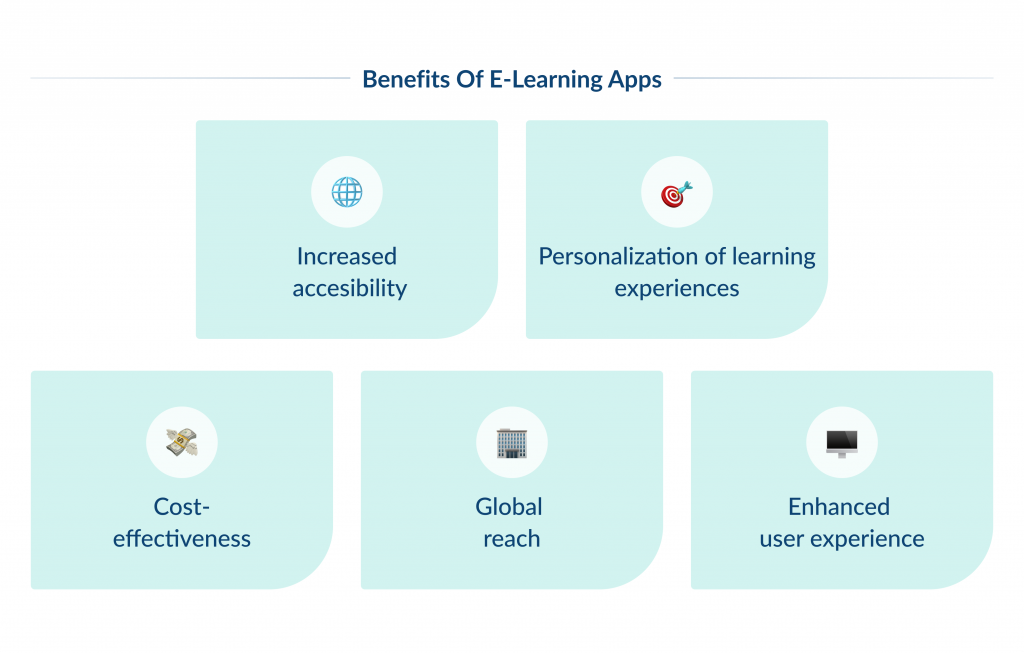
Turning your app idea into reality? Learn how to start an app step by step.
Business & Revenue Models of eLearning Apps
Spreading education across the world is a great mission, but for your business to survive, you need revenue.
eLearning apps use a variety of business and revenue models to generate income.
Here are some of the most common revenue models you can benefit from:
- Subscription Model
Users pay a recurring fee (monthly or yearly) to access all or a specific set of courses on the platform. This is common in platforms like Coursera and LinkedIn Learning.
Subscription model offers a continuous learning experience for a steady stream of revenue.
- Freemium Model
Basic content is offered for free, but users must pay for premium features like advanced courses, certifications, or personalized learning experiences.
Duolingo, for instance, provides free language learning with the option to upgrade for additional features.
- Pay-Per-Course Model
Users pay for individual courses or programs, either as a one-time payment or through installment plans.
This model works well for platforms like Udemy. Learners pay for specific skills they want to acquire.
- Certification Fees
Platforms offer free access to course materials but charge for a certificate upon course completion.
This model enhances learning while generating revenue through the sale of official certifications. You can see it on Coursera or edX.
- Corporate Training Model
This revenue model is beneficial for apps that provide customized training solutions to businesses.
Companies pay for access to courses or a learning platform to train their employees.
This is a significant revenue stream for platforms like LinkedIn Learning and Skillsoft.
- Ads-Based Model
In this model, the platform is free to users but generates revenue by displaying advertisements.
This is often seen in apps targeting a large user base with free content, such as Khan Academy’s use of YouTube ads.
- Marketplace Model
In this approach, eLearning platforms act as intermediaries, allowing instructors to sell their courses.
The platform takes a commission on each course sale.
Udemy and Teachable are good examples, where educators can monetize their expertise.
- Licensing
Some platforms license their content to schools, universities, or businesses.
The institutions pay a fee to use the eLearning platform’s resources, creating a recurring revenue stream.
Which revenue model should you choose?
The best thing is that you can combine several models depending on your target audience, content, and business goals.
Understanding ARR is essential for scaling. Use ARR calculator to keep track of your performance.
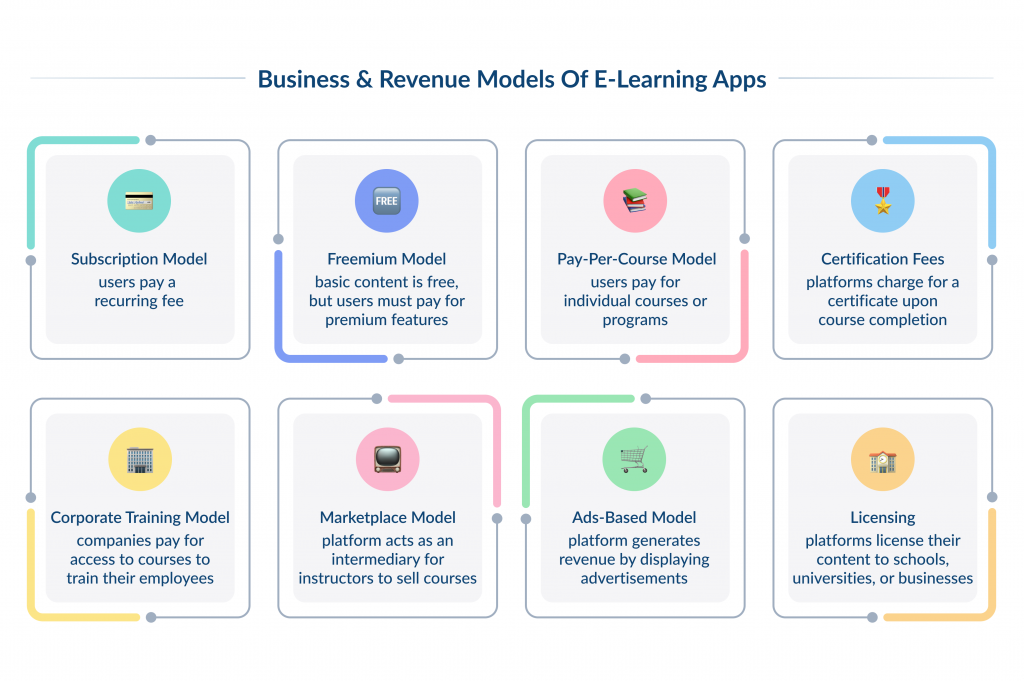
Is e-Learning Effective?
This is something many people might wonder before downloading their first (or one more) educational app.
The study on the effectiveness of e-learning conducted by Schack Noesgaard and Ørngreen highlights the main factors that influence how effective e-learning can be.
Among them are the following aspects that make online learning software more efficient:
- A supportive learning environment makes sure learners have access to resources and help.
- A person’s motivation and past experience with online learning or professional work also impact their success.
- Well-designed e-learning should encourage interaction between learners and instructors and offer practical opportunities to apply new knowledge.
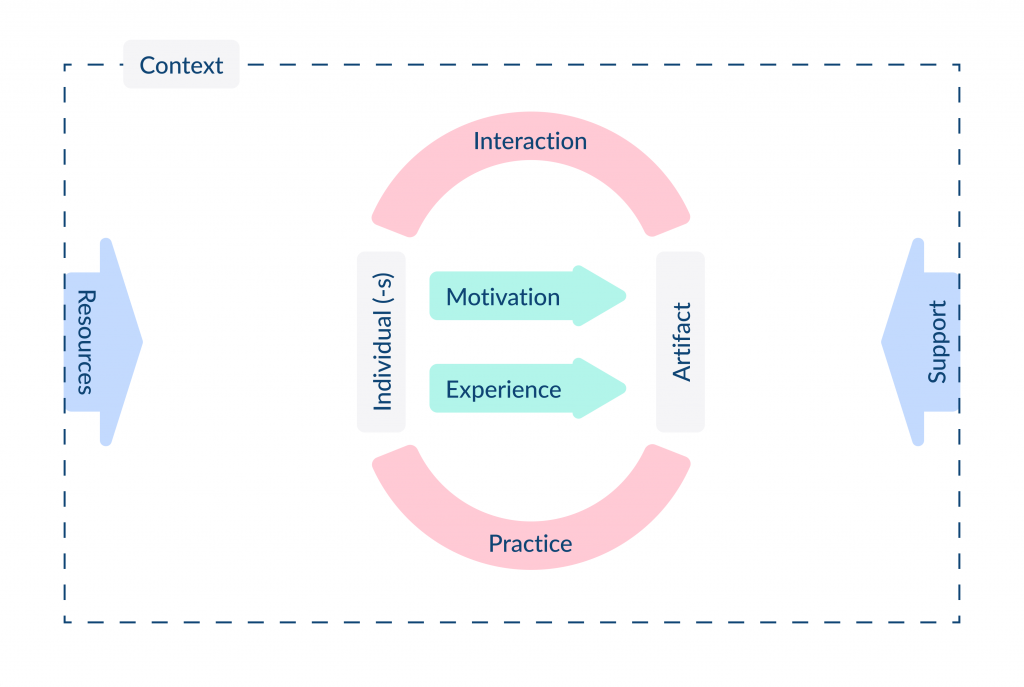
Keeping these factors into account, let’s discover the must-have features your educational app should have to make the learning process more effective and interactive.
Key Features of Online Learning Applications
When you think about the key features you want to add to your elearning mobile app, it’s crucial to consider aspects that make these platforms effective, engaging, and user-friendly.
It is worth noting that the exact set of features will always depend on your business goals, target audience, and type of app you want to build.
Based on the industry growth trends, here are some must-have features we would add when providing educational app development services for our clients.
Personalized Learning Paths
Even though personalization is a great feature for almost any type of application, it carries a lot of benefits for e-learning specifically.
For instance, you can build a personalized dashboard with recommendations where users can see the r courses they should take next based on their preferences.
With AI-driven personalization, you can tailor content to individual learners’ needs and adjust lessons based on their performance.
This feature allows students to focus on areas they need to improve and provides a more efficient learning experience.
Progress Tracking and Analytics
One of the most valuable features for both learners and educators is the ability to track progress.
This can be done in the form of various quizzes, assignments, and course completion statistics.
Learners can see what they are good at and where there is room for improvement.
This will keep them motivated and aware of their development.
Teachers, in their turn, can use these analytics to adjust content and support.
Platforms like Coursera offer dashboards that display completion rates, quiz performance, and overall progress. It helps users to stay motivated and measure success.
Mobile Accessibility
Everyone wants to be able to learn on the go because, let’s admit it, we all have busy lives and sometimes the only chance for us to learn something new is on the go.
That is why mobile learning app development is so popular. In fact, over 50% of all downloaded apps are used for learning.
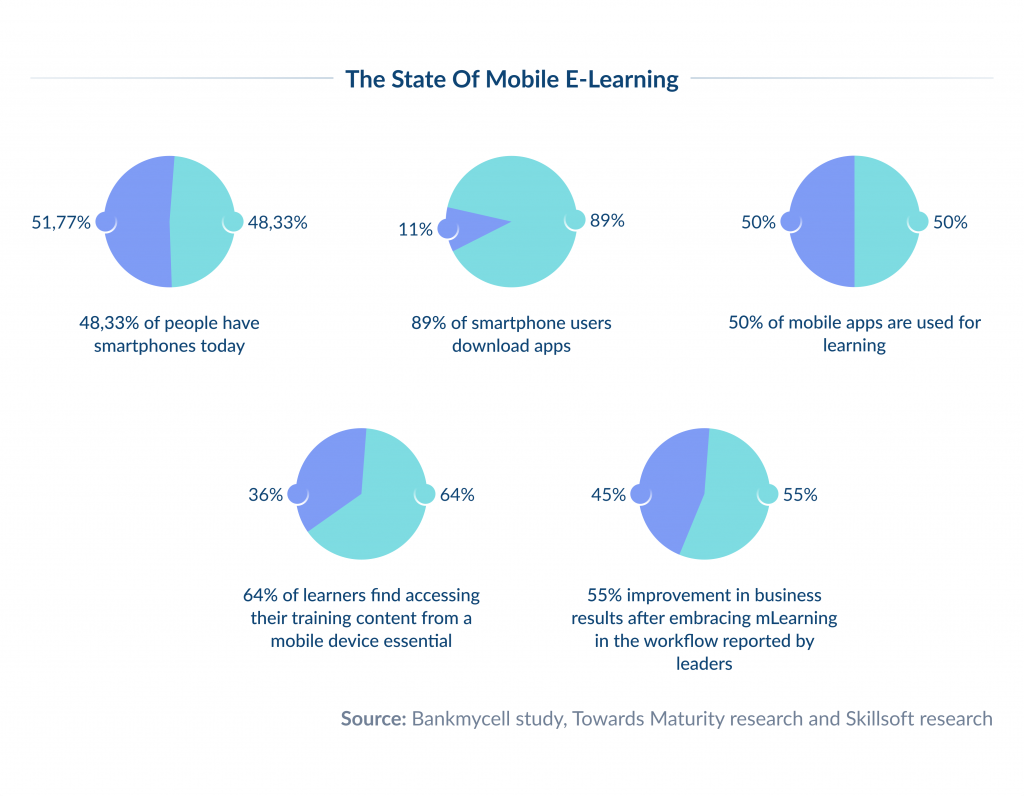
This is especially handful when we talk about language learning apps, as they are the most popular e-learning applications on the market.
Interactive and Immersive Content
Interactive features like gamification, quizzes, simulations, and AR are something that will help your app stand out.
Curious about the growth of augmented reality? Our AR statistics provide valuable insights.
These tools encourage active participation, helping learners retain information better by making the experience enjoyable and hands-on.
Duolingo, for example, uses gamification to encourage language learning, while healthcare apps might include simulations for hands-on practice.
Explore the potential of healthcare app ideas to make a meaningful impact in healthcare.
Another example is the Microsoft Hololens mixed reality headset, which enables medical students to gain an in-depth, visual understanding of human physiology and various medical conditions.
This level of interactive detail was never available in education before the advent of such technologies.
Check out our educational app ideas to see what are the best elearning apps you can build.
Live Classes and Virtual Classrooms
Even though elearning is on the go, live interaction with students is a must.
Virtual reality tools like classrooms offer face to face learning experiences, just like in person teaching, through video calls and live Q&A.
With the right tools, like online whiteboards, chat rooms and file sharing the virtual classroom experience can be the same or better than in person.
Certification and Credentialing
Offering certificates or credentials upon completion is a key feature for many apps, especially in professional development.
LinkedIn Learning and Google’s Career Certificates are the ones that offer industry-recognized certifications that help learners get hired.
Multimedia Support
E-learning platforms provide a variety of content types, from videos and podcasts to articles and interactive quizzes.
This variety helps cater to different learning styles, ensuring that users stay engaged and better retain information.
For instance, extended reality can enable students to visualize distant stars and solar systems as interactive 3D elements right in front of them!
Innovative apps, like Froggipedia, can demonstrate a frog’s biology and internal organs using AR technology without harming a specimen.
Discussion Forums and Peer Interaction
Social learning features like discussion boards and peer review are all about making eLearning more interactive.
These tools allow learners to connect with others in the same course, ask questions and share their experiences so learning doesn’t feel so lonely.
Peer reviews like edX allow students to review each other’s assignments, get a fresh perspective, and help both the reviewer and the student learn more.
These interactions create a sense of community and make learning more dynamic and collaborative.
Schack Noesgaard and Ørngreen’s study on e-learning effectiveness says social learning leads to higher satisfaction and application of knowledge, especially in e-learning where real world practice is limited.
These features help online learning apps deliver personalized, flexible and engaging learning experiences that meet the needs of modern learners and professionals.
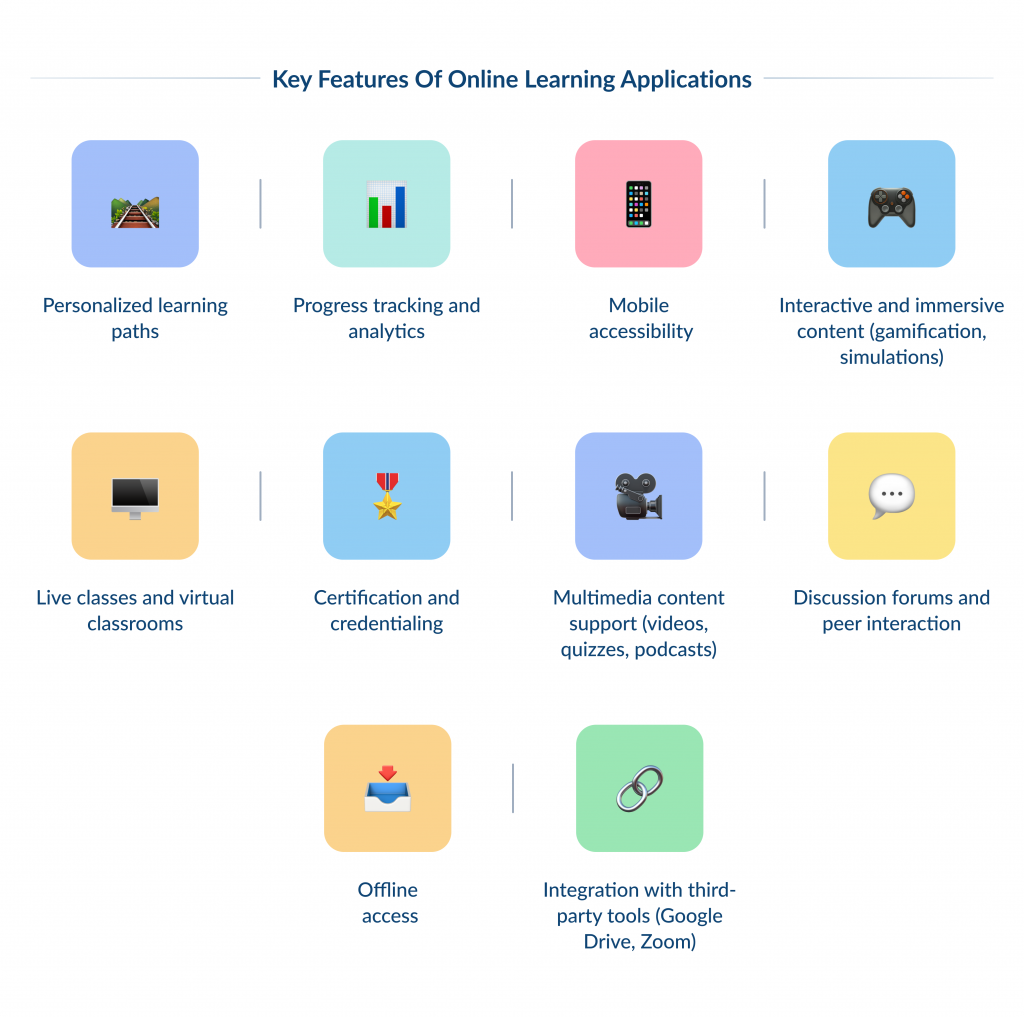
The app development landscape is evolving. Explore the most important application development trends for your business.
Tech Stack for Developing Online Learning Apps
Choosing the right tech stack is one of the most important decisions you’ll make when building an online learning app. See how to choose a tech stack for your project.
It’s not just about picking the latest tools but selecting the right combination of technologies that ensure your app runs smoothly, grows easily, and keeps user data safe.
From creating a seamless mobile experience to managing back-end performance, every piece of the puzzle matters.
In this section, we’ll break down the essential technologies to help you build a powerful and reliable platform, designed to meet both today’s needs and future demands.
Type of Technology |
Example |
| Front-end |
Curious about the price of building an iOS app? Our iOS app development cost guide breaks it down. |
| Back-end |
|
| Database |
|
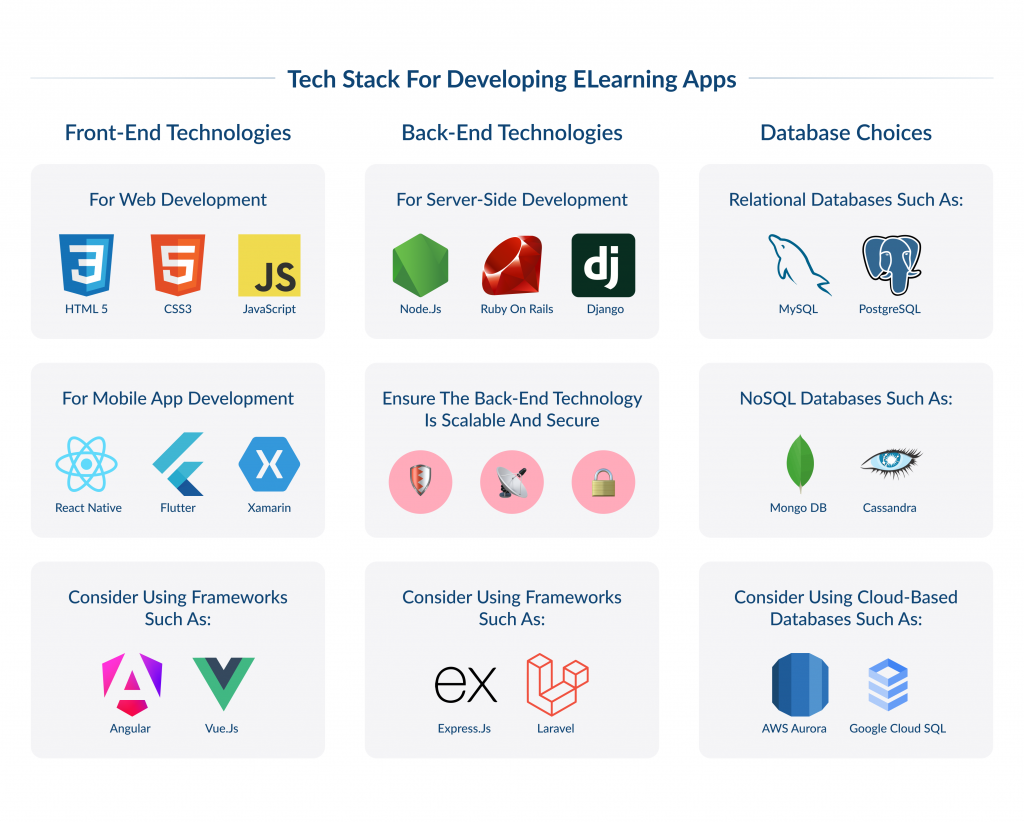
8 Steps to Develop an eLearning App
At SpdLoad, we have been developing e-learning apps for over ten years.
We have developed an e-learning management system for the school of aviation, a popular English learning app, and modern e-learning platform that connects students with businesses, and much more.
If you are planning to build your educational application with us, here is a step-by-step process we use.
Of course, we may adjust the steps based on your goals and needs.
Find out how long it really takes to develop an app with our comprehensive guide on how long it takes to develop an app.
Step 1. Market Research
You can’t develop a successful app without thorough market research.
This is the first step where we explore the market to investigate your target audience, competitors, and current trends in e-learning.
We take some time to better understand who your learners are, their pain points, and what they expect from an online learning experience.
Then, we look at competitor apps to identify strengths and gaps in the market.
This insight helps us shape the app’s features, design, and content to address real user needs.
When done right, market research saves you time and money as it prevents you from misaligned features or functionality.
Explore examples of good web design that combine functionality and creativity.
Step 2. Selecting Core Features
At this point, we already know who we are building the app for and what potential users need and expect from a learning app.
This is a perfect time to point out the must-have features that will make your app user-friendly and engaging.
We prioritize essential elements like personalized learning paths, progress tracking, and multimedia content (videos, quizzes, podcasts).
It’s crucial to balance between necessary features and user overload. So, we focus on a few key functionalities that will set your app apart.
A clear set of core features helps maintain focus during development and prevents your app from being too complex or too simple for users.
Step 3. Monetization Model
Decide how your app will generate revenue: subscription models, freemium plans, or in-app purchases.
Consider your audience’s ability to pay and how they perceive value.
Offering different pricing tiers can help attract a broader user base, while premium content or advanced features can boost revenue.
Your monetization strategy should align with your long-term goals, balancing profitability with accessibility to create sustainable growth.
Step 4. MVP Development
MVP in business allows you to launch a simplified version of your app with only the essential features.
This lets you test your concept with real users and gather early feedback, which can guide further development.
The MVP should provide core functionality but leave room for future improvements based on user behavior.
This approach minimizes risk, speeds up time-to-market, and ensures you’re building something people actually want.
Whether you’re a startup or a seasoned pro, this guide on MVP design will save you time and money.
5. QA and Testing
Testing is key to a smooth user experience.
We test your app on multiple devices, operating systems, and browsers to find bugs or performance issues.
During testing we focus on functionality and user experience. We also look at security, speed and screen sizes.
A polished, bug-free app makes a good first impression and reduces churn.
If you’re running split tests, A/B testing calculator can help you accurately determine results.
Testing is crucial to app success. Learn how to test a mobile app the right way.
6. Launch
Launching is not just about releasing the app – it’s about getting it in front of the right people.
To make sure it does, we can work together to plan a marketing strategy that includes app store optimization (ASO), social media campaigns and partnerships with education influencers (see how influencer marketing for startups can work for you).
Try our CPM calculator to measure ad efficiency based on cost per thousand impressions.
You need to track your app’s performance post launch using analytics tools to see how it’s doing and where you need to improve.
If your app doesn’t get a million downloads on day one – it’s okay.
Learn how to craft effective email marketing strategies for startups to boost engagement.
Looking for marketing support? Discover the key steps to outsourcing digital marketing effectively.
7. Listen to User Feedback and Iterate
Once live, listen to user feedback.
Reviews, surveys and in-app analytics will tell you what’s working and what’s not.
Prioritise updates based on this to keep the app relevant and fun.
Regular iterations will help you refine the user experience, add new features and fix any issues that come up.
Listening to your users will improve your app and your relationship with them.
8. App Maintenance
After launch, app stability is key.
Regular updates to fix bugs, security and new OS versions.
Provide good customer support to fix user issues quickly and add new features based on trends and user requests.
This will keep your app working, secure and looking good ,which is important for the long term success.
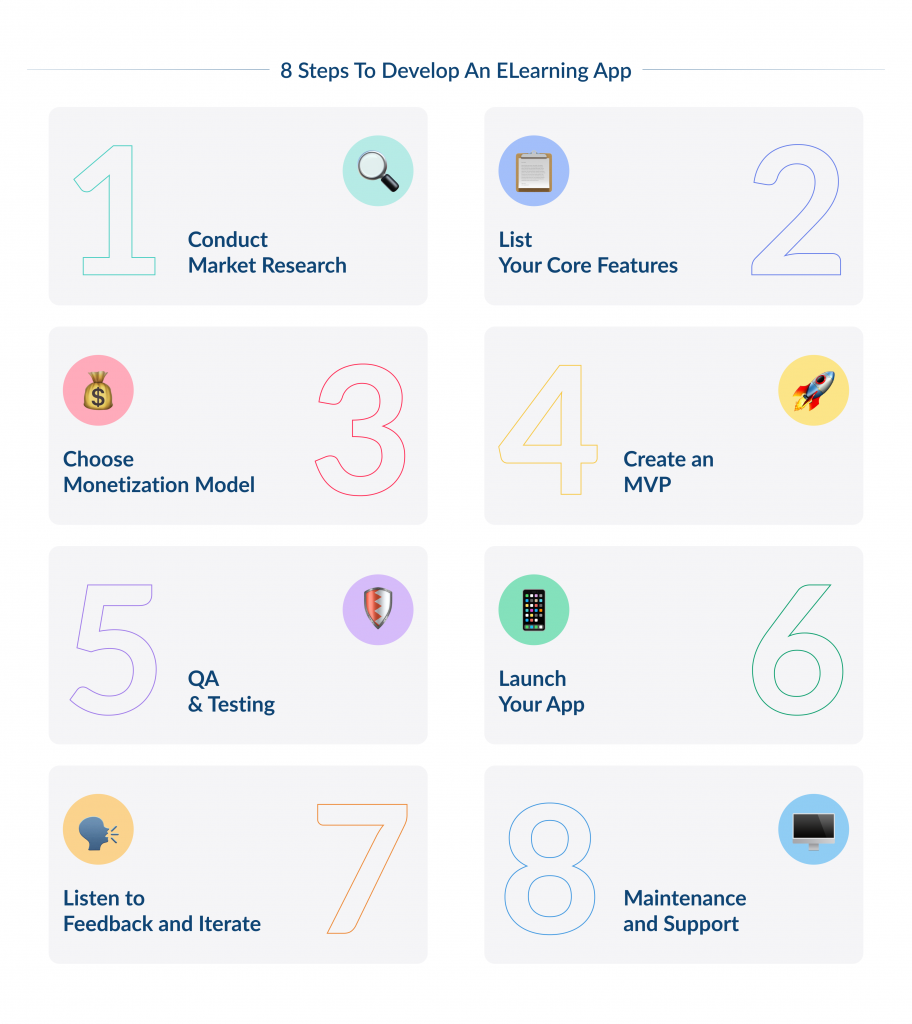
How Much Does it Cost to Create an eLearning App?
When planning to build an eLearning app, it’s wise to estimate costs upfront.
There are several factors that influence the price.
These include app features, design, size, and in-app purchases.
An elearning app with basic features and limited functionality will be cheaper, while more complex ones will cost more.
If your budget is limited, you are in the middle of the fundraising process, or just want to save costs without sacrificing quality, offshore outsourcing can be a great option.
Discover the benefits of IT outsourcing and why it’s popular for scaling tech needs.
The location of your development team is a primary pricing factor.
Feel free to explore our guide on best countries to outsource software development where we break down popular outsourcing destinations, their pros and cons.
Also, the number of developers needed depends on the app’s complexity.
Typically, developers charge $40-$60 per hour, so an app requiring 2,000 hours of work can cost between $80,000 to $120,000 and more, depending on the features and their complexity.
The cost of developing an app can vary widely. Get a clear idea of what to expect with our guide to app development costs.
Challenges of Building eLearning Applications
eLearning app development comes with its challenges.
Here are the main obstacles companies may face when developing their educational apps and how to overcome them.
Scalability and Performance
As more users join your app, you need to make sure it can handle the increased traffic without slowing down or crashing.
That means you need to design the app with scalability in mind.
At SpdLoad, we optimize the app’s performance with backend tweaks and cloud services to manage high traffic and fast interactions during peak hours.
Mobile and Cross-Platform
Keep in mind that users will access your app from different devices.
So, it must look and work well on mobile, tablets, and desktops.
Making sure your app is mobile-friendly and works on both iOS and Android and web browsers requires planning and testing.
If you’re planning to build an app, this detailed guide on Android app development costs will help you navigate the financial aspects.
Also, here’s a look at the best iOS app development tools for creating standout mobile apps.
Data Privacy and Security
Protecting user data is key, especially in educational platforms where people often share their personal data.
You need to comply with regulations like GDPR or FERPA. User data must be encrypted and stored securely.
Learn what is FERPA compliance and how it helps institutions uphold these values.
To maintain security, you need to conduct regular security checks and secure user logins. This will help you build trust and prevent breaches.
Explore our guide to cybersecurity trends and see what your organization needs to stay secure.
Integration with 3rd Party Tools and APIs
eLearning apps rely on integrating tools like video conferencing platforms, payment systems, and content management services.
Getting these external tools to work with your app can be tricky but it’s necessary to add value.
The integration must be seamless to avoid technical issues.
UX under High Load
When many users are accessing the app at the same time, the experience must be smooth.
A slow app or one that crashes will lose users fast.
To prevent this, you need to optimize both the backend and front end to handle high traffic so your users don’t face delays or interruptions.
Outsourcing can streamline your app development. Here’s a complete guide on finding the right mobile app developers.
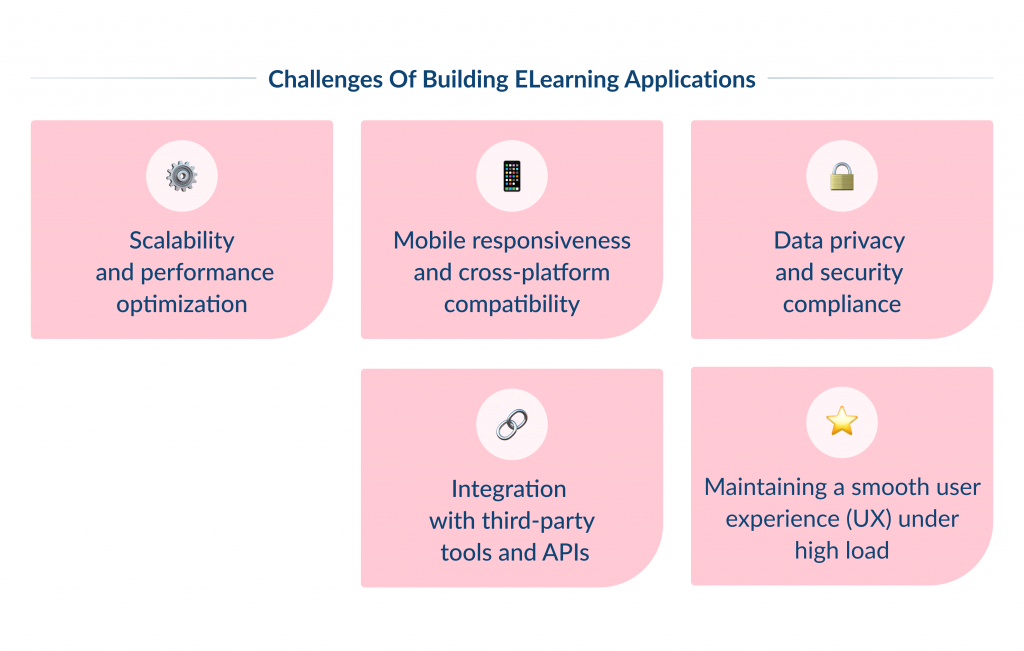
Looking to streamline the development process? Here are some helpful app development tips to guide you.
Choosing the Right Development Partner
Choosing the right app development partnership is crucial for the success of your app development project.
When making your choice, make sure you check out their case studies and reviews and have a brief conversation to see if your vision and goals align.
This is a hard choice to make, especially considering the fact that there are a lot of good outsourcing companies out there.
To make your life a little bit easier, we have outlined the most important factors to consider when choosing an outsourcing partner:
| Factor | Description |
| Expertise | Before choosing a learning app development team, it’s crucial that you first consider their knowledge about EdTech and the types of educational apps they have built. Having a successful product goes beyond just creating a product; you need professionals that understand your market demands. They should also know how to create a product that fits.
Both are essential. Want to build a productive remote team? This guide on high-performance remote teams shows you how. |
| Reviews | Check out their Clutch, LinkedIn profile, and any other social network to verify information that supports their expertise. |
| Portfolio |
Before you hire your team, check their portfolio to see the success of their previous projects. It’s proof of the team’s capabilities and skills. Here you can explore our case studies. |
We hope that the information we shared in this blog will help you better understand the process of educational app development, its challenges and opportunities.
If you are looking for a software development company with expertise in elearning app development, contact us.
Want to stand out in a crowded market? Check out this guide on developing a brand strategy for startups.




